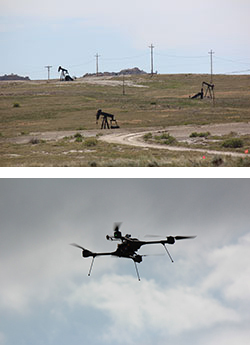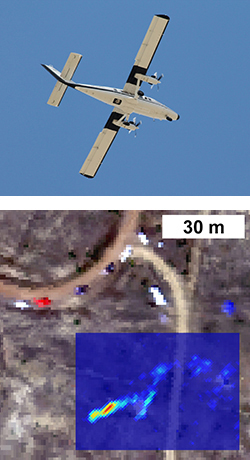
Bottom: JPL small Unmanned Aerial System (sUAS) equipped with a miniature methane sensor.
Image Credits: NASA/JPL
Many gases present in Earth’s atmosphere contribute to global climate change. Methane, a key component of natural gas, is a particularly potent greenhouse gas, with a much higher global warming potential than carbon dioxide on 20-year timescales. In an effort to develop new technologies that can characterize methane emissions, JPL participated with the other partners in a recent field experiment and science program at the Rocky Mountain Oil Testing Center (RMOTC), a DOE-operated testing center located about 35 miles north of Casper, Wyo. The partners flew several airborne instruments to detect and measure methane emissions. The experiment results will provide valuable data to the community about the sensitivity achievable using current remote sensing instruments and effective deployment strategies for detecting human-produced and natural methane emissions.
As efforts to extract gas and oil from unconventional sources for energy production increase, it is critical to use advanced techniques to monitor large areas, such as oil basins. A common goal of science and industry is to support the responsible production of natural gas and promote technologies that can detect and attribute natural and human-produced methane emissions. Such technologies will provide the means to help achieve continuous improvement in safe and responsible gas production. Thus, it is a priority to demonstrate the usefulness of sensors that can accurately track and attribute such methane emissions.
“RMOTC’s mission is to ensure America’s energy security and prosperity by assisting our partners in the development and commercialization of energy-efficient and environmentally-friendly technologies to address critical global energy challenges,” said Grant Evenson of RMOTC.
The field experiment at RMOTC (June 20-26, 2013) was designed to measure methane abundances released at different controlled rates using a suite of ground-based and airborne instruments. Three airborne sensors were flown on separate conventional aircraft in conjunction with a small unmanned aerial system (sUAS) and arrays of in situ sensors. JPL was responsible for deploying the airborne instruments and sUAS while LANL provided ground-based sensor and modeling capabilities.

Bottom: Imaging spectrometer data product produced from flights on June 20, 2013, during a 1,090-meter overflight with AVIRIS-ng at a methane controlled release site (0.9-meter spatial resolution). Shown as bottom layer is the true color image where vehicles appear in the North of the image. The top layer shows the prominent methane plume from the scene overlain atop the controlled release point. The methane plume shows higher concentrations near the release point and distribution is consistent with the wind direction, as measured by ground instruments.
Image Credits: NASA/JPL.
During the campaign, JPL deployed the Next Generation Airborne Visible and Infrared Imaging Spectrometer (AVIRIS-ng), the Hyperspectral Thermal Emission Spectrometer (HyTES), and the Carbon in Arctic Reservoirs Vulnerability Experiment (CARVE) instrument suite. All of the airborne sensors can detect enhanced concentrations of methane from ground sources.
“We organized deployment of a suite of state-of-the art instruments available for methane detection whose performance in controlled release testing will demonstrate their usefulness for methane remote sensing – preliminary results from our data analyses reveal detection of robust plume signatures from these controlled experiments,” said Andrew Aubrey, project manager at JPL. “This study demonstrated tools that can be used for investigations of natural and human-produced methane emissions, while also informing us about the performance expected from the next-generation remote sensing instruments currently being designed at JPL.”
Once the JPL and LANL instruments were ready, methane was released at precise metered rates and observed by arrays of sensors each mounted on a 45-foot tower downwind of each release site. The experiment was designed to provide detailed information on the structure and variability over space and time of methane plumes using both ground-based sensors and the airborne instruments. This approach provides for a robust validation strategy between the remote sensing and ground sensors to validate these cutting-edge sensing approaches.
Results and publications of findings are forthcoming, but this experiment at RMOTC could demonstrate advanced technologies that might fill current gaps for monitoring and gas detection over large spatial scales. Methane measurements are particularly relevant given their importance to global climate change and the co-aligned goals of commercial and government sectors to better understand and mitigate fugitive methane emissions.
Additional information is available from the LANL press release.